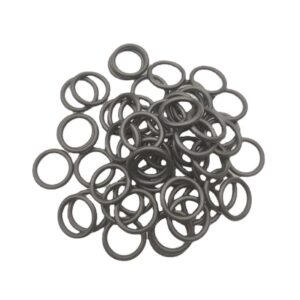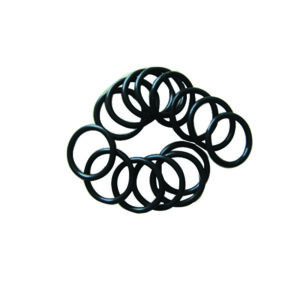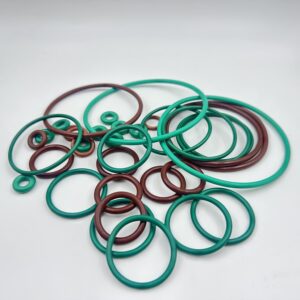Table of Contents
ToggleAre There Different Types of O-Rings?
Yes, O-rings are not a one-size-fits-all solution. They are engineered in diverse types to address specific operational demands, including material compatibility, environmental conditions, and mechanical requirements. Below is a comprehensive classification of O-ring types, organized to highlight their distinct characteristics and applications.



1. Material-Based Classification
The choice of material directly impacts an O-ring’s performance in temperature extremes, chemical exposure, and pressure. Key materials include:
- Nitrile (NBR/Buna-N):
Cost-effective and widely used for petroleum-based oils, fuels, and hydraulic fluids. Ideal for automotive engines, machinery, and industrial systems. Temperature range: −40°C to +120°C. - Viton® (FKM/Fluorocarbon):
Resists high temperatures (up to 250°C), fuels, acids, and solvents. Common in aerospace, chemical processing, and fuel systems. - Silicone (VMQ):
Excels in extreme temperature stability (−60°C to +230°C) and biocompatibility. Used in medical devices, food processing, and aerospace static seals. - EPDM (Ethylene Propylene Diene Monomer):
Superior resistance to ozone, weathering, and steam. Ideal for outdoor HVAC systems, brake systems, and water applications. - Neoprene (CR):
Balances moderate chemical resistance with durability against refrigerants and ozone. Common in refrigeration and marine equipment. - PTFE (Teflon®):
Chemically inert and handles extreme temperatures (−260°C to +260°C). Often used in semiconductor manufacturing or as a jacket over elastomer cores. - FFKM (Perfluoroelastomer):
Premium material for aggressive chemicals and ultra-high temperatures (up to 300°C). Critical in semiconductor, oil/gas, and pharmaceutical industries.
2. Application-Based Classification
O-rings are categorized by their operational context:
Static Seals
Used between stationary surfaces (e.g., pipe flanges, valve covers, tank lids). They rely on compression alone and excel in long-term, stable environments.
Dynamic Seals
Designed for moving components, subdivided into:
- Reciprocating Seals: Handle linear motion (e.g., hydraulic pistons, rods). Require abrasion resistance and anti-extrusion properties.
- Rotary Seals: Optimized for rotating shafts or spindles. Use low-friction materials to minimize wear.
High-Pressure Seals
Reinforced with backup rings or PTFE jackets to prevent extrusion in hydraulic/pneumatic systems.
Vacuum Seals
Made from low-outgassing materials (e.g., silicone, FFKM) to maintain vacuum integrity in space or laboratory equipment.
3. Dimensional Standards
O-rings adhere to global sizing standards for interchangeability:
- AS568 (SAE Standard):
The U.S. system using dash numbers (e.g., -112, -214) to define inner diameter and cross-section. - Metric Sizes (ISO 3601):
Common in Europe and Asia, specified in millimeters (e.g., 5mm x 2mm). - BS (British Standard):
UK-specific sizing, such as BS 1516. - Extended Series:
Custom sizes (e.g., 400-series) for non-standard or heavy-duty applications.
4. Specialized Features
Advanced O-rings include enhancements for niche requirements:
- Coated O-rings: PTFE coatings reduce friction and improve chemical resistance.
- Conductive O-rings: Dissipate static electricity in electronics or explosive environments.
- Color-Coded O-rings: Simplify material identification (e.g., blue for silicone, green for FFKM).
- FDA/USP-Class VI Certified: Safe for food, pharmaceutical, or medical use.
5. Hardness (Shore A Durometer)
Hardness determines flexibility and pressure tolerance:
- Soft (50–70 Shore A): Conforms to uneven surfaces for low-pressure sealing.
- Medium (70–90 Shore A): Balances flexibility and durability (most common).
- Hard (90+ Shore A): Resists deformation in high-pressure systems.
6. Manufacturing Methods
- Molded O-rings: Seamless, uniform, and ideal for precision applications.
- Extruded & Spliced O-rings: Cost-effective but weaker at the splice joint.
Key Selection Criteria
- Temperature: Silicone for extremes; Viton® for sustained high heat.
- Chemical Exposure: PTFE or FFKM for aggressive chemicals.
- Pressure: Harder materials (90+ Shore A) or PTFE jackets.
- Motion: Dynamic seals require abrasion-resistant compounds.
- Regulatory Compliance: FDA, MIL-SPEC, or ATEX certifications for industry-specific needs.
Examples of Optimal Use
- Automotive Fuel Systems: Viton® resists gasoline and high heat.
- Pharmaceutical Equipment: PTFE ensures chemical inertness.
- Outdoor HVAC: EPDM withstands UV and ozone degradation.
Conclusion
O-rings are far from uniform. Their diversity in materials, applications, sizes, and specialized features ensures tailored solutions for virtually any sealing challenge. By evaluating factors like motion, temperature, and chemical exposure, engineers can select the optimal O-ring type to enhance system reliability and longevity. Always consult compatibility charts and standards to align your choice with operational demands.



Leave A Comment